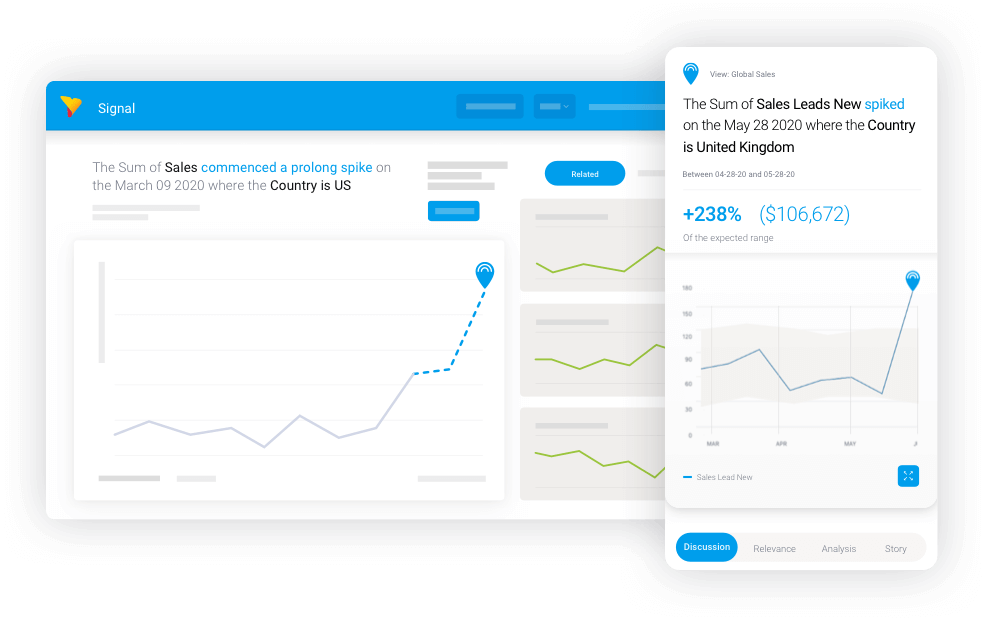
How to accelerate digital transformation with Automated Business Monitoring
Driving rapid digital transformation with automation and analytics is possible, but businesses must take the time to understand how the technology solves their issues first.
With automation becoming more user-friendly and streamlined than ever before, it's understandable organizations across sectors are examining how it can enhance their analytics capability and accelerate their business shift toward digital transformation.
But before any meaningful transition toward digital or successful adoption of automation can occur, it's critical to recognize the need to spend the necessary time identifying and evaluating what problem need solving, and how the tech can be used to fulfil that need.
In this blog, we discuss the optimal way to accelerate digital transformation using automated analytics technology, such as Yellowfin Signals, and the importance of aligning the solution with your business needs - at every stage of the journey.
But first - what is the challenge to getting there the right way?
Buzzword bingo: Why it's creating a problem for successful transformation with automation
Automated business monitoring (also known as ABM or automated analytics) is an exciting and emerging technology for businesses seeking greater sophistication in their operational workflows, with many use cases such as real-time inventory management.
The problem? A lot of companies look for augmented technologies like ABM and under an alarming sense of urgency rush to adopt it based on ‘FOMO’ - or fear of missing out.
Yellowfin have often spoken to prospects experiencing FOMO, who request demos of our automated analytics capability like Signals, but have trouble answering the following:
- What is the problem you need to solve with technology such as automated analytics?
- How can adopting Signals' automated analytics features alleviate your problems?
- What part of the business do you want to apply tools like automated Signals to?

It's true there are several mature technology solutions today - not just in automation - that have been proven to help businesses transition toward digital transformation easier than years past, and the longer your organization waits to automate processes and systems, the bigger the chance you could be left behind competitively.
But if you try to drive this journey too quickly and invest in technology to fulfil an unclear checklist, without being able to articulate the business problem you're trying to solve, you can also be left behind with a costly new product feature that nobody uses optimally.
Imagine having an automated analytics tool that could make real-time inventory management or instant notification of sales spikes possible - but your users instead keep doing things manually. It's most likely because they don't understand its place.
Aside from FOMO, the biggest challenge to successful digital transformation with automated analytics is a lack of assessment on how to deliver such technology to users.
The average business user that could benefit from automated analytical tools to improve efficiency may not be an analyst or even technical in nature, and if you adopt a tool like Signals, you want it to become core to their workflow rather than a complex roadblock.
So, what's the right away to approach analytics? Through careful, divided stages.
Learn more: What is Yellowfin Signals?
Driving rapid value with automated business monitoring - a phased, manageable approach
The first, most important step to leveraging automated analytics solutions like Signals successfully is by understanding what problems you need to solve, then looking at the best solutions on the market that align with your current pain-points. Investing the appropriate time to determine which tools are best-fit for your problems in smaller, focused chunks means you avoid allowing problems like FOMO to rush your decisions.
Divide the transition into stages so you can acquire wins on the way, learn from smaller mistakes without suffering bigger setbacks, and take your business through the entire journey toward digital. Most importantly, you have more time to figure out what works.
To help illustrate this approach, we recommend looking at Yellowfin manufacturing customer KYOWA's story. The company spent significant time in identifying what the specific business problems it wanted solved were - stockouts, also known as out of stock (OOS) events - then carefully researched what and how technology could solve it.

KYOWA discovered its stockouts were caused by its inefficient manual processes and human error, which led to significant opportunity loss. Armed with this knowledge, it then had time to narrow the issue down further, discovering that because staff entered inventory count in Excel spreadsheets, there was a reliance on certain people to organize demand planning every day. This then led to missed items with a small stock (stockout) and misjudged timing to order. By the time KYOWA engaged Yellowfin, it already knew:
- What they wanted to use Signals for - to solve their stockout
- How it could help - by removing reliance on users and manual input
- What part of the business it could be used in - its entire production side, where Signals' automatic detection and instant notification of changes in data could warn them ahead of time to prevent future OOS events.
Because KYOWA took the time to align its business problems with the best-fit technology, it was also able to deliver Signals to its team in a way that everyone could begin consuming their data, leveraging automated detection and notifications instantly.
Driving successful transformation with automated analytics: Key takeaways
While automation is proven to accelerate the shift to digital, success is only possible with a careful, strategic approach to transformation in manageable, focused stages that allow you to identify the best solutions to problems, and take the full business on the journey.
KYOWA made sure to educate its team on how to use and maximize Signals' capabilities so that the technology's integration into its core inventory control workflow was smooth and that the benefits of the adoption were clearly articulated and understood by all.
In the current landscape we live in, it's understandable the pressure to shift to digital is increasing dramatically. But it is critical to recognize the need be clear with your business and the vendor you choose on what you’re trying to achieve with the technology first.
Customer Success Story: How KYOWA transformed its inventory management with Yellowfin Signals
Read the full story on KYOWA - how the company adopted Signals and used automated business monitoring to unlock real-time inventory management, eliminate stockout events and reduce opportunity loss to almost zero.